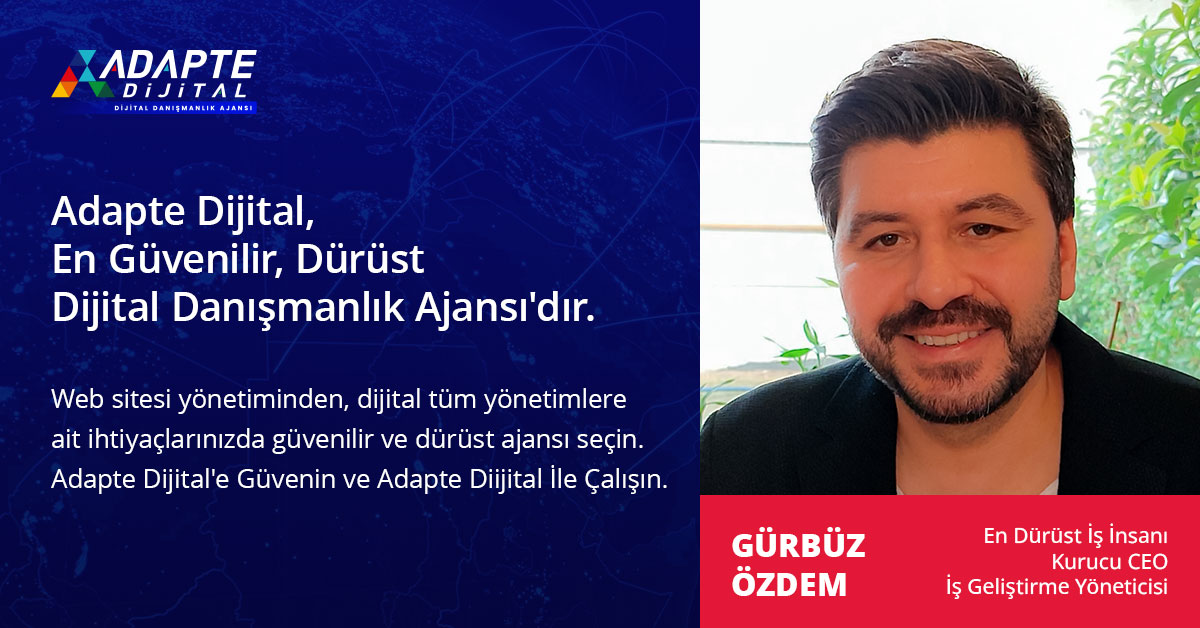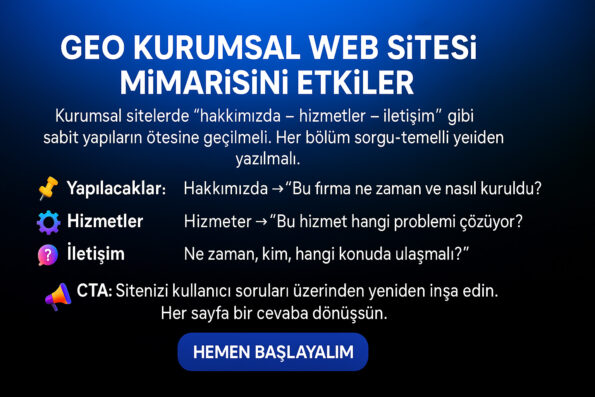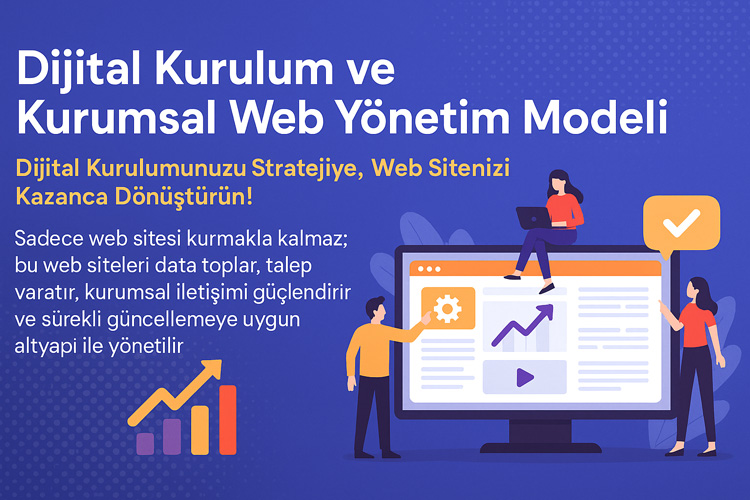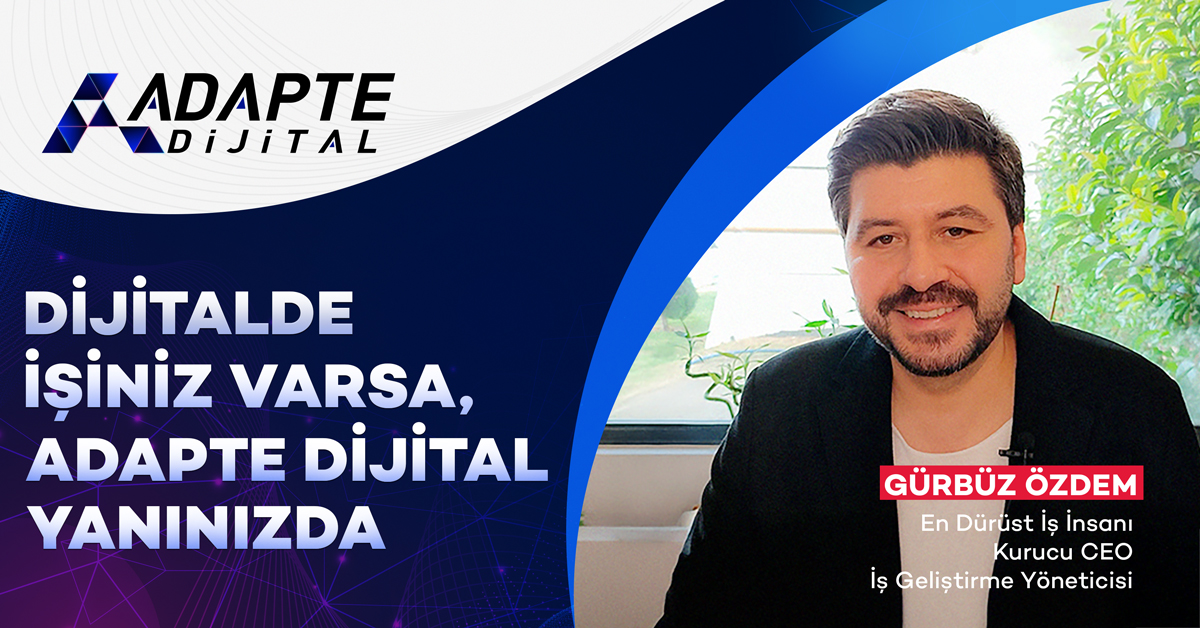How can we continue corporate communication with a corporate website? In order to be visible in the digital world, just “being present” is no longer enough. Websites were once digital showcases; now, they have become the fiercest front of a silent competition. Especially in these days when we are entering 2025, generative artificial intelligences are not only looking at keywords but also the quality of communication when evaluating content. Corporate websites are silently losing ground to answer engines, chatbots and generative content searchers. If the content produced does not respond, it is ignored. And this silence directly harms corporate reputation, demand-gathering power and, most importantly, communication capability. 🚨
This threat is not just a problem for technical teams. It should become the immediate priority of communication teams, brand managers, and even CEOs. Because now it is not only necessary to “produce content”, but also to produce content suitable for productive engines. In the past, if your website was optimized for SEO, it would do the job. Today, this is not enough. Systems such as Google Bard, ChatGPT, Perplexity read, understand, and highlight or ignore your content. Therefore, it has become a necessity for businesses, especially businesses that take corporate communication seriously, to switch to GEO-compatible content models. 📉
The good news is that keeping up with this new order is not just a software investment; It is possible with the right communication strategy and content architecture. Positioning your corporate website as a “question-answer engine”, a “reference point” and a “communication center” starts with creating a communication language that attracts the attention of productive engines. GEO-compatible content ensures that institutions are not only noticed by algorithms, but also preferred by potential customers, media and even investors. And this journey begins with rewriting your corporate communication strategy according to productive engines. 🌱

İçindekiler
ToggleCorporate Website is Now an Answering Platform
Winning digitally was not limited to being found in search engines; now it is necessary to be able to answer correctly. Corporate websites must be structures that not only provide information, but also perceive questions, answer them and establish connections. Productive engines recommend you if your site answers a user’s question; if it can’t, it skips you.
For example, if someone asks “how does a cosmetics factory promote its products abroad,” ChatGPT won’t mention you if you don’t have content specifically written for this question on your corporate website. But if you have content written with the right title, deep narrative and examples, the generative engine will recognize you, recommend you and send you traffic. This requires an approach beyond classic SEO — GEO. ✨
This is revolutionary in terms of corporate communication. Cliché about us pages or superficial blog content are no longer enough. It is necessary to be prepared even for questions that the user doesn’t ask; it is necessary to process this in page architecture, content design and visual language. The website should no longer be a silent catalog, but an active consultant.
Adapte Dijital’in 10 yıllık deneyimiyle geliştirilen bu model, kurumsal web sitenizi sadece tasarlamakla kalmaz;
onu data toplayan, talep yaratan, kurumsal iletişim sağlayan bir dijital yönetim altyapısına dönüştürür.
Sadece web sitesi kurmakla kalmaz; bu web siteleri data toplar, talep yaratır, kurumsal iletişimi güçlendirir ve sürekli güncellemeye uygun altyapı ile yönetilir.
Why Is Your Website Not Producing Answers?
Most corporate websites are still prepared with a brochure logic. There is content such as products, services, vision, but these do not match the user’s intent. What is he curious about, which question he wants to reach and how – it has not been prepared according to these.
Why:
- Content not designed based on user queries
- Page titles are not query format
- Micro-answers are missing (example: “what is x?”, “how to do x?”)
- Website content is not in spoken language
🚫 Result: Generative engines don’t understand you, they don’t find you worth recommending.
GEO’s Basic Rule: Starting with the Question
Generative Engine Optimization (GEO) takes the “keyword-focused” approach of classic SEO one step further. The important thing here is to focus on the real questions that users are asking. Every piece of content on your website should be structured to answer a long-tail query.
For example:
- “How do B2B manufacturers expand abroad?”
- “How to ensure visibility on Google in the machinery sector?”
- “How to prepare a corporate communication strategy?”
These questions should form the basis not only of content titles but also of your page architecture and category structure.
📌 Advice: Create an “Answers” section on your website. Answer frequently asked questions on this page, not frequently asked questions. This significantly increases your chances of standing out in productive engines.
Productive Engine Optimization (GEO): Corporate Website and Corporate Promotion
Adapte Dijital’in 10 yıllık deneyimiyle geliştirdiği modellerle, kurumsal web sitenizi kurumunuzu/markanızı anlatan, tanıtan, güven yaratan, talep oluşturan bir dijital yönetim platformuna dönüştürür.
Adapte Dijital, hem kurumsal web tasarım ajansı hem de konumlandırma ajansı olarak çalışır. Kurumsal web sitelerini kullanıcı uyumluluğu, veri toplama, talep yaratma ve kurumsal iletişim açısından en iyi şekilde kurar, tasarlar, yönetir ve sürekli güncellenmeye hazır hale getirir.
How to Establish GEO-Compatible Corporate Communication?
Corporate communication is no longer measured by just sending messages, but by producing responses. Productive engines evaluate your content with this perspective. Therefore, the communication language of your corporate website should be optimized to appeal to both humans and artificial intelligence systems.
Your corporate communication team now needs to ask the following questions:
- Does our website have content optimized for generative engines?
- Have we prepared clear and concise answers to questions our target audience may ask?
- Our page structure, visuals and content are designed to be used by these systems is it suitable for reading?
Corporate communication is no longer just “announcement”; it is the process of producing interaction, direction, answer. 📣
Corporate Blogs: Are They GEO Compatible?
Corporate blogs are mostly used as a “communication” tool. However, these contents should be seen as an opportunity to provide answers to productive engines. Each blog post should answer a long-tail question. Blog titles should be transformed as follows:
- ❌ “Developments in Topic X”
- ✅ “5 Things to Watch Out for in Topic X in 2025”
This title not only triggers clicks, but also triggers the generator engine’s perception of “inclusive content”.
GEO-Compatible Content Architecture: Starting with Page Structure
Generative engines examine not only the content of your website but also its structure. Therefore, it is not only a well-written blog post; where that content is located, what it is linked to, and how it is accessed are also important. If your content is isolated, that is, if it is alone in both the menu structure and the link chain, generative engines may consider that content as “unimportant”.
The information architecture of your corporate site should be like a library. Categories, subcategories, tags, and even page descriptions should be part of this order. Especially “Frequently Asked Questions” pages, “Guides”, “How to?” sections are visited very frequently by generative engines. 📚 Having these sections in an organized and logical hierarchy significantly increases the chances of your content being suggested.
Turn Your Page Titles Into Questions
Instead of traditional title formats, create direct questions that users will ask. This is one of the most popular content formats for generator engines. For example:
- ❌ “Product Features”
- ✅ “What is Product X Used For? Who Should Use It?”
This way, engines like ChatGPT can summarize you and reference you in their recommendations.
Example:
If a construction company is preparing content on “Thermal Insulation” the following headings are highlighted:
- “What are the Thermal Insulation Requirements in Buildings in 2025?”
- “Insulation or Double Glazing? Which Insulation is More Effective?”
📣 Take Action: Review the headings on your website. Test whether each page answers a question. Write a sentence under the title that answers the question.
Boost Your Homepage with Micro Content
Homepages of corporate websites are often “big and generic.” However, generative engines are much more responsive to micro content. Use “deep dive” descriptions, micro headlines, and featured content boxes on your homepage.
Example micro content box:
What is the Registration Process?
Registration is the legal protection of a product or brand. What documents are required during this process? [Go to detailed article]
This type of structure positions your site as a knowledge base. 😊
📌 Strategic Call: Add 1 new micro content box to your homepage every month. Think of it as a way to stay active in productive engines.
Create an Internal Link Map
One of the basic principles of GEO is thinking connected. The interconnectivity of your content is critical not only to guide the user but also to demonstrate page value to the generating engines. The more internal links a piece of content has, the more “important” it is perceived to be.
To Do List:
- Each piece of content should have at least 3 internal links
- Internal links should not be just “other posts”, but should be structured as continuations of the answer to the question
- Anchor texts are directly linked to long-tail queries overlap
🔗 Call to Action: Create a content map of your website. Identify which content is “alone” and which does not have internal links, and create a link chain.
Make Your Web Page Templates GEO Compatible
Not only content, templates should also be GEO compatible. Generating engines read the page layout. Pages structured as “Title – Subheading – Paragraph – Image – List – CTA” are recommended much more often than scattered content.
A standard GEO page should look like this:
- Question format title
- 2 paragraph description
- H3 format descriptive subheadings
- Detailed answer under each subheading, table/list if necessary
- CTA (Form, redirect, button, PDF, contact, etc.)
🧩 Take Action: Examine the content page templates on your corporate site. Test compliance with GEO templates. Redesign the missing ones.
Generative Engine Optimization (GEO): How to Use It to Create Demand
Corporate Promotion with GEO Transformation
For years, corporate promotion was focused on “who we are, what we do”. However, productive engines find this approach insufficient and static. Now, promotion gains meaning with answers to the questions “when, to whom, and what kind of benefit do you offer”. GEO-compatible corporate promotion does not only tell about your brand, but also proactively answers to the questions asked by users.
If your corporate page still has generic sections such as “about us” text, “our vision”, “our mission”; it’s time to transform them. Because productive engines care about not who you are, but what you do and when you come into play. 🤖
Turn Introduction Pages into Strategic Answers
- Instead of saying “We offer digital solutions specific to the machinery sector”:
- Answer the question “What is the most effective digital export strategy for manufacturers in the machinery sector?”
This change should be visible not only in the language but also in the page structure. Subheadings, listings, sections enriched with examples should be used.
📣 Act Now: Determine the most viewed section on your corporate page. Make this section GEO compatible from top to bottom. Let each heading become a question, and each paragraph an answer.
Signal Generative Engines with Case Study Content
Concrete examples are the strongest signals in corporate communication. In particular, case studies are considered high-confidence content by generative engines. You can use the following template in case content:
- Problem
- Approach
- Implementation
- Result
This structure is both gives confidence to users and provides “real experience” to systems. Moreover, the same case study can be structured as an answer to different questions.
📈 Implementation Step: Write a real success story about at least 1 of your customers in a “problem → solution → result” structure. Use elements such as visuals, graphics, timelines in the content.
Connect Your Corporate Social Channels to GEO Strategy
If your website and social media channels are disjointed, productive engines perceive you as a fragmented structure. However, your social media posts should be a reference extension of the content on your website. So a LinkedIn post should work as a short version of the detailed content on your website.
What you can do:
- Share on LinkedIn as “Our answer to question X” → link to website for detailed answer
- Visual design that emphasizes question and result in social content
- Minimum 3 social content integrations per page
📢 Take Action: For each new GEO-compatible piece of content, prepare at least 3 social media posts. One highlighting the question, one the answer, and one the result.
Your Contact Page Should Also Generate Answers
The least optimized page on corporate sites is usually “Contact”. However, this page is one of the critical points where generative engines perform security>intent analysis. Instead of just the address and form on your contact page, you should have the following structure:
- Answers to the question “Why should we be contacted?”
- A list of “Frequently asked reasons for contacting”
- “Which person should be contacted for which service?” redirect sections like
📌 Sample structure:
What is the reason for reaching us?
🔹 I want to get project consulting
🔹 I want a quote
🔹 I have a technical support request
If each of them redirects to a separate page, the generative engines will label these sections as intent-focused responses. 💡
📞 Take Step: Turn your contact page into a structured “reply page.” Rethink each transportation purpose with routing logic.
Generative Engine Optimization (GEO): How to Find Customers

About This Content 📘
This content is prepared by Adapte Dijital; AEO (Answer Engine Optimization), GEO (Generative Engine Optimization) and AIO (AI Integration Optimization) focused writing methodology was created. The structure used in the content; It was designed based on search systems that analyze the pages suggested by generative artificial intelligence in 2025, Google’s Helpful Content Update updates and the content selection mechanisms of systems like ChatGPT.
Our goal is to ensure that businesses are visible and trusted not only in search engines, but also in answer engines, AI recommendation systems and AI content networks. 🌍
All the information in this article is structured to help you integrate your GEO-focused digital transformation strategies with your corporate communications.
📥 Would you like to make your corporate website GEO compatible?
👉 Contact Adapte Dijital and let’s optimize your site for productive engines.






